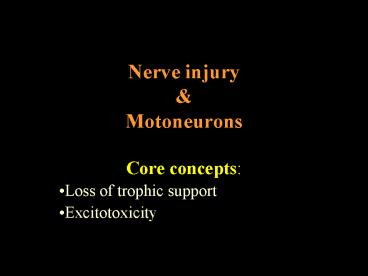Nerve injury - PowerPoint PPT Presentation
1 / 28
Title: Nerve injury
1
Nerve injury Motoneurons
- Core concepts
- Loss of trophic support
- Excitotoxicity
2
Causes of motoneuron death
NOCD
Early postnatal injury
Disease SMA ALS PMN
3
Motoneuron disease
- 5000 affected in UK
- 1-2/100,000 new cases p.a.
- Affects men gt women
- Onset gt40 years of age
- 55-65 yrs old most commonly affected
- Genetic
- Not possible to prevent onset
- Symptoms
- Progressive muscle weakness wasting
- Hands, arms legs usually affected first
- May get spasticity, painful cramps loss of
balance - Affects vocal respiratory muscles
4
Clinical syndromes
- Spinal Muscular Atrophy
- Hereditary condition defect in SMN gene
- (Chromosome 5q12.2-q13)
- Insufficient peripheral motor sprouting
- Increased motoneuron activity excitotoxicity?
5
Clinical syndromesAge related motoneuron loss
- Senile Muscular Atrophy
- Affects 15 of elderly population
- 10-20 motoneuron loss
- Motoneurons show signs of damage
- ? CGRP, GAP43, p75
- ? trkB, trkC
6
ALS
- Affects UMN/LMNs
- Mechanisms
- 10 Hereditary (SOD1)
- Oxidative stress
- EAA toxicity
- Glial EAAT2 abnormal
- ? Glutamate in CNS
- ? Glutamate in CSF
- NOS, Cox 2 induced
- Defect in RA pathway
7
Goals of neuromuscular disease research
- Prevent death
- Maintain phenotype
- Repair neuronal damage
8
Trophic factors and motoneuron survival
BDNF, NT3, NT4 GDNF, NTN, PSN LIF, CNTF,
CT1 FGFs RA HGF IGF1
BDNF, NT3, NT4 GDNF LIF, CNTF FGF5, bFGF IGF1,
IGF2
9
NOCD trophic factor knockout
NGF- trk A No motoneuron loss BDNF/NT4 - trk
B No motoneuron loss NT3 - trk C No motoneuron
loss p75 No motoneuron loss BDNF-NT4 double
KO No motoneuron loss trk B/C double KO No
motoneuron loss CNTF No motoneuron
loss CNTFR? 40-50 LOSS LIFR? LOSS gp130 40
LOSS GDNF- GFR?1 20-40 LOSS GFR?2 No
motoneuron loss c-RET Significant loss
10
Motoneuron survival depends on age
P0 90 P3 80 P4 30 P5 0
and post-operative survival time
11
Neonatal motoneuron death depends on lesion site
- Motoneuron loss also depends on duration of
deprivation - P0 axotomy 1 survival
- P0 crush 10-30 survival
- Delayed reinnervation P5 P10 crush 60
survival
YES ?
? YES
Yes
12
Is motoneuron death due to axon damage per se or
target deprivation?
- Motoneuron loss is regulated by target
deprivation - can be induced by NMJ blockade at birth
(maintains MN immaturity)
injury induced release of glutamate (kills
immature MNs) Can be mimicked by NMDA injection
13
Motoneuron death is regulated by target contact
Growing mode Transmitting mode
Muscle induced neuro-transmitter release
Ach
14
Motoneuron death is regulated by target contact
Growing mode Preserved immature
state
Death by glutamate excito- toxicity
Prevention of neuromuscular interaction No
induced neuro-transmitter release
15
Motoneuron maturation
Growing neurone transmitting
neurone
16
Neonatal axotomy effects on surviving neurons
- Biochemical
- ? expression, Reg2, HSP27, GFR?1, p75, CGRP, CB,
gp130, trkC, CNTFR? - ? expression GAP43, c-Jun, NOS, NR1, NR2B, GAL,
mRNAs for LIF, trkB, c-RET
- Physiological
- ? neuronal activity
- abnormal reflex patterns
- ? dendrite number, altered morphology
17
Pharmacological manipulations that rescue dying
motoneurons
- Neurotrophic support
- Preventing excitotoxicity
- Important Outcomes
- Permanent survival
- Rescued motoneurons must reinnervate muscles
- Muscles must develop adequate force on
reinnervation - Spinal circuits must be re-established
18
Neurotrophic support
1 week 2 weeks
combination nerve s.c
P3 sciatic cut single dose NTF treatment to
injury site
19
Neonatal neurotrophic support
- Transient rescue
- BDNF lt 3 weeks
- NT3 lt 2 weeks
- NT4 lt 1week
- CNTF lt 2 weeks
- LIF lt 2 weeks
- GDNF
- combinations
- Restore ChAT levels
- Permanent rescue
- GDNF (AAV)
- Deleterious
- NGF (activity dependent)
- High dose BDNF
- receptor desensitisation or activity dependent
20
Adult motoneuron death
YES ?
? NO/ YES -delayed
NO
21
Adult nerve injury
- Loss of normal function
- Loss of reflex function
- Soma atrophy
- Motor c.v. ?
- ? ChAT
- ? transmitter receptors
- No cell death
- VRA
- Repeated nerve injury
- Regeneration
- ? GAP43, c-Jun
- ? CGRP, GAL,
- ? REG2
- ? HSP27
- ? c-Ret, GFR?1, LIFR, p75, CNTFR?, trkB
- ? gp130, ? trkC
22
Exogenous NTFs reverse effects of injury
aid regeneration
? NGF, BDNF, GDNF, NT4
?
?trkB GFR?1 p75
Regeneration GAP43, CGRP Tubulin
?CNTF, ? NT3
?p75 ?? apoptosis in Schwann cells ? ?
regeneration
23
Adult injuries that killRepeated nerve injury
? SA
EAA toxicity
? BDNF, GDNF, NT4
?
?trkB GAP43 p75
?
or ? Schwann cell derived trophic factors
- Immature state
Regeneration mode
24
Adult injuries that kill Avulsion
Exogenous BDNF, GDNF prevents death
No transport of Schwann cell derived NTFs
EAA toxicity
?
?trkB GFR?1 p75 NOS
No access to Schwann cells
Regeneration possible ? GAP43, CGRP, Tubulin
Activation of p75 death pathway?
25
Rescuing dying motoneurons Preventing
excitotoxicity
- Riluzole
- NOS inhibitors
- Glutamate inhibitors MK801
26
(No Transcript)
27
Clinical trials in ALS
- CNTF severe side effects fever, chest pains,
muscle weakness, herpes virus activation - BDNF Major side effects. Pain.
- IGF1 data not conclusive drug well tolerated
- GDNF, NTN not tested
- TCH346 (anti apoptotic) failed phase 2 trial
- Riluzole activity blocker
- Retinoic acid RALD2 RAR?
28
References
- Lowrie MB Vrbova G 1992 TINS 15 80-84
- Greensmith L Vrbova G 1995 Neuro-muscular
Disord 5 359-69 - Vejsada R et al 1995 EJN 7108-115
- Ma J et al. 2001 139 216-223































